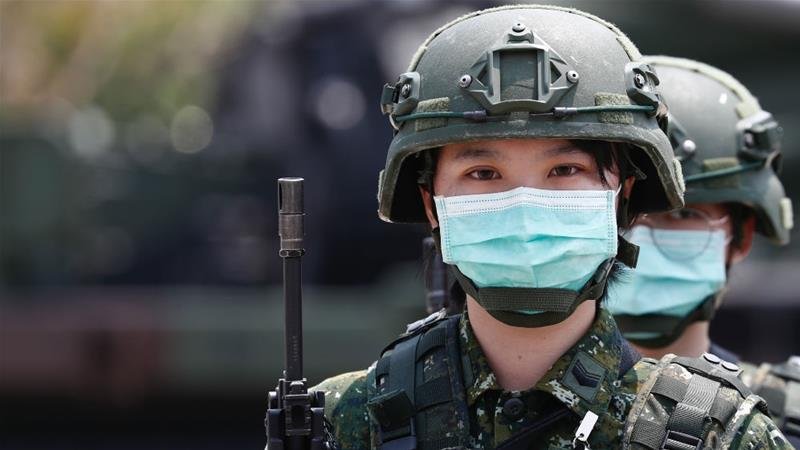In shadow of coronavirus, China steps up manoeuvres near Taiwan
China has increased military activity around Taiwan, as the island’s success in tackling coronavirus boosts soft power.
Taipei, Taiwan – Beijing has escalated the number and intensity of military drills around Taiwan in recent weeks, making risky manoeuvres that appear set to test the political waters in Taipei and Washington while signalling the mainland’s continuing animosity towards Taiwanese president Tsai Ing-wen, who was re-elected in a landslide in January.
While China has long held military exercises in Taiwanese territorial waters and airspace, this month the People’s Liberation Army Airforce conducted a 36-hour endurance exercise. Just last week, China’s aircraft carrier Liaoning and a convoy of five warships sailed close to Taiwan through the Miyako Strait, according to Taiwanese media. In March there were reports of the People’s Liberation Army Air Force’s (PLAAF) first-ever night mission.
The exercises have been “particularly aggressive,” said Bonnie Glaser, director of the China Power Project at the Center for Strategic and International Studies. “These are definitely intended to send messages of intimidation to Taiwan [and] test Taiwan’s air defences to see how long it takes them to identify that they are incoming to scramble the aircraft in response to see how well Taiwan’s pilots fly when they are intercepted.”
The PLAAF’s night mission in March crossed the median of the Taiwan Strait, an unofficial maritime border between Chinese and Taiwanese territory. China’s Communist Party claims sovereignty over Taiwan, formally known as the Republic of China, although it has never governed the democratically run island of 23 million.
The PLAAF conducted similar exercises in March 2019 for the first time in 20 years, said Glaser, but since then there have been several other exercises with more than two dozen aircraft involved.
Provocative moves
The drills are politically significant for Taipei and Beijing, says Kharis Templeman, an adviser to Project on Taiwan in the Indo-Pacific at the Hoover Institution, Stanford University.
“Crossing the median line is an especially provocative manoeuvre because it violates a norm that has been in place since the 1950s, and it could lead very quickly to a dangerous confrontation in the air between ROC and PRC military aircraft,” he said. Republic of China (ROC) is the official name for Taiwan; PRC stands for the People’s Republic of China.
He said in recent months exercises have increased in quantity and qualitatively as Beijing continues to ramp up the political pressure on Taiwan.
The exercises also come as Taiwan and its unofficial ally, the US, have seen their defensive capabilities affected by the coronavirus pandemic, which has infected sailors in both navies.
“One thing we’ve been paying more attention to in the current situation is China seems to be testing the water and see how much they can do to threaten the government of Taiwan and see the potential response from the US,” said Yao-Yuan Yee, the assistant coordinator of the Taiwan and East Asia Studies Program at the University of St Thomas in Minnesota.
This week Taiwan announced it would delay the first half of its annual Han Kuan war games, which each northern spring simulate an invasion from China, although it has continued to intercept jets and shadow Chinese aircraft when they approach its airspace, according to Stanford’s Templeman.
After the US air force conducted a long-distance exercise over Taiwan in February, US President Donald Trump, meanwhile, recalled all strategic bombers from Guam. The military base is the temporary home of USS Theodore, which was forced to dock following a coronavirus outbreak on board.
The aircraft carrier has previously conducted freedom of navigation exercises near Taiwan in the South China Sea and Sea of Japan.


Comments are closed.